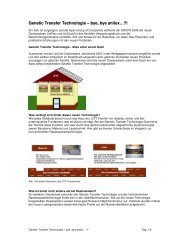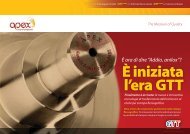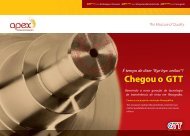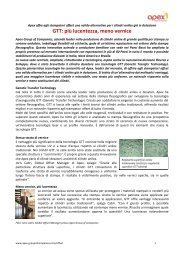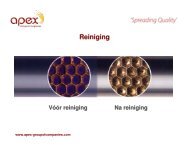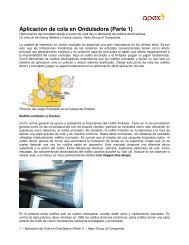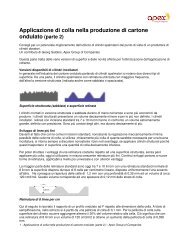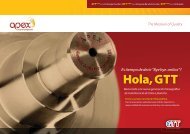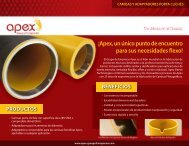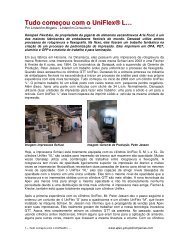Glue Application in Corrugators - Apex-groupofcompanies.com
Glue Application in Corrugators - Apex-groupofcompanies.com
Glue Application in Corrugators - Apex-groupofcompanies.com
Create successful ePaper yourself
Turn your PDF publications into a flip-book with our unique Google optimized e-Paper software.
<strong>Glue</strong> <strong>Application</strong> <strong>in</strong> <strong>Corrugators</strong> (Part 1)<br />
Optimisation potential from the viewpo<strong>in</strong>t of a meter<strong>in</strong>g roll manufacturer.<br />
An article by Georg Selders, <strong>Apex</strong> Group of Companies<br />
Good pr<strong>in</strong>tability of corrugated board has <strong>in</strong>creas<strong>in</strong>gly ga<strong>in</strong>ed <strong>in</strong> importance dur<strong>in</strong>g the last few years. The<br />
mechanical limits of conventional glue application systems <strong>in</strong> particular often result <strong>in</strong> excessive and uneven<br />
glue application, which can negatively <strong>in</strong>fluence the pr<strong>in</strong>tability of corrugated board. The glue and doctor rolls<br />
acquire special importance here. As meter<strong>in</strong>g roll manufacturers, we see the glue and doctor rolls not simply<br />
as an application system, but also as a very precise meter<strong>in</strong>g system. Viewed from this angle, the glue and<br />
doctor rolls <strong>in</strong> themselves have a high potential for optimis<strong>in</strong>g glue application.<br />
Position<strong>in</strong>g of the glue set <strong>in</strong> the s<strong>in</strong>gle facer<br />
Doctor roll<br />
The importance of the doctor roll is often considerably under-estimated. Whether <strong>in</strong> documentation or <strong>in</strong><br />
discussions with the customer – the glue roll is actually always to the fore. However, the doctor roll is also a<br />
determ<strong>in</strong><strong>in</strong>g factor for precise glue application. Previously, conventional glue plants were equipped with<br />
chrome rollers as standard. Generally, the doctor roll is wiped with doctor blades that can <strong>com</strong>prise very<br />
diverse materials. This automatically leads to board<strong>in</strong>g (formation of stripes) and related height differences,<br />
which are generally not detectable when the rolls are fitted. However, these height differences ultimately result<br />
<strong>in</strong> different film layer thicknesses <strong>in</strong> the glue gap. As a result, the meter<strong>in</strong>g characteristics of the roll change<br />
dur<strong>in</strong>g the overall period of use. With backlight<strong>in</strong>g, these height differences be<strong>com</strong>e clearly visible. (see<br />
illustration above)<br />
In practice, however, the rolls are often only replaced <strong>in</strong> the case of clearly visible and deep-seated damage.<br />
Aga<strong>in</strong>st this background, we <strong>in</strong>troduced ceramic doctor rolls to the corrugated board <strong>in</strong>dustry for the first time<br />
<strong>in</strong> 1996; these rolls have a highly wear-resistant chrome oxide coat<strong>in</strong>g that prevents board<strong>in</strong>g.<br />
1 – <strong>Glue</strong> <strong>Application</strong> <strong>in</strong> <strong>Corrugators</strong> (Part 1) – <strong>Apex</strong> Group of Companies
Due to the <strong>in</strong>creas<strong>in</strong>g quality requirements of recent years, we now almost exclusively manufacture ceramic<br />
doctor rolls. The advantages <strong>in</strong> <strong>com</strong>parison with conventional chrome rolls are:<br />
Advantages of ceramic doctor rolls:<br />
– Surface hardness HV 1450-1550<br />
– Surface roughness max. RA 0.8 /RZ 6.3 with move favourable surfacecharacteristics<br />
(surface tension)<br />
– Concentricity tolerances T.I.R. max. 10 µm<br />
– Form variation over the entire roll max. 10 µm<br />
– Diameter tolerance accord<strong>in</strong>g to mach<strong>in</strong>e manufacturer’s specifications<br />
Both new rolls and exist<strong>in</strong>g chrome rolls can be designed with ceramic surfaces. In addition to the even glue<br />
film, this design guarantees a longer and, above all, more consistent lifetime.<br />
<strong>Glue</strong> roll<br />
On closer exam<strong>in</strong>ation, various problems emerge <strong>in</strong> connection with the glue roll. These <strong>in</strong>clude, <strong>in</strong> particular:<br />
diameter, corrosion, mechanical stress, concentricity tolerances <strong>in</strong> conjunction with the doctor roll, excessive<br />
or uneven glue application, clean<strong>in</strong>g problems and many other issues depend<strong>in</strong>g on the specific situation,<br />
such as, for example, <strong>in</strong>creased mach<strong>in</strong>e speed, build-up of hydraulic pressure <strong>in</strong> the gap, aquaplan<strong>in</strong>g, air<br />
problems, squirt<strong>in</strong>g, pack<strong>in</strong>g, etc.<br />
Roll diameter<br />
In pr<strong>in</strong>ciple there are two ways of renovat<strong>in</strong>g glue rolls. For example, the glue roll can be desurfaced to the<br />
po<strong>in</strong>t of the deepest damage, restructured or l<strong>in</strong>e-patterned and then chrome plated. However, this results <strong>in</strong><br />
considerable under-dimension<strong>in</strong>g of the roll with repeated treatment. This is considered very critical, as rolls<br />
with vary<strong>in</strong>g diameters automatically <strong>in</strong>fluence the meter<strong>in</strong>g situation. Practice has shown that this can lead to<br />
unforeseeable problems with regard to gap sett<strong>in</strong>g, and that even with an identical gap sett<strong>in</strong>g the glue<br />
application quantity changes due to the change <strong>in</strong> the differential speed of the rolls <strong>in</strong> relation to each other. In<br />
addition, this type of roll renovation is effectively a “one-way street”, which means that a new roll body will<br />
have to be manufactured at some po<strong>in</strong>t <strong>in</strong> time.<br />
The second method of renovat<strong>in</strong>g glue rolls <strong>com</strong>prises desurfac<strong>in</strong>g the glue roll to the po<strong>in</strong>t of the deepest<br />
damage, build<strong>in</strong>g up the diameter with copper, steel or sta<strong>in</strong>less steel to the orig<strong>in</strong>al diameter, and only then<br />
structur<strong>in</strong>g or l<strong>in</strong>e-pattern<strong>in</strong>g and, if necessary, chrome-plat<strong>in</strong>g the roll. This has the advantage that the sett<strong>in</strong>g<br />
and meter<strong>in</strong>g situation <strong>in</strong> the mach<strong>in</strong>e is not changed by replacement of the roll.<br />
Our <strong>com</strong>pany rejects the concept of build<strong>in</strong>g up glue rolls with copper <strong>in</strong> pr<strong>in</strong>ciple, as this soft <strong>com</strong>position<br />
results <strong>in</strong> a reduced lifetime. Instead, we use the specially developed AST steel fusion method, <strong>in</strong> which the<br />
orig<strong>in</strong>al diameter of the rolls is restored with steel or sta<strong>in</strong>less steel. (see illustration below). The surface<br />
quality and lifetime of a roll renovated us<strong>in</strong>g this method is equivalent to that of a new roll. In addition, this<br />
method can be used as often as desired, if the body structure is good.<br />
Sta<strong>in</strong>less steel glue rolls<br />
2 – <strong>Glue</strong> <strong>Application</strong> <strong>in</strong> <strong>Corrugators</strong> (Part 1) – <strong>Apex</strong> Group of Companies
On account of <strong>in</strong>creased quality requirements and the further development of surface structures (l<strong>in</strong>e<br />
patterns), glue rolls are now predom<strong>in</strong>antly manufactured <strong>in</strong> sta<strong>in</strong>less steel. The reason for this can be clearly<br />
seen with the help of the follow<strong>in</strong>g case study: a chrome-plated glue roll is removed after 9 months and sent<br />
back by the customer for <strong>in</strong>spection, with the <strong>com</strong>ment that the chrome-plat<strong>in</strong>g on the roll is poor. The<br />
cover<strong>in</strong>g note <strong>in</strong>dicates that the l<strong>in</strong>e pattern is not mechanically damaged and the cell structure is visibly wellpreserved,<br />
but the chrome-plat<strong>in</strong>g appears to be poorly executed, as the roll is already show<strong>in</strong>g signs of<br />
corrosion.<br />
At first glance, one might share this op<strong>in</strong>ion, but closer exam<strong>in</strong>ation of the roll surface results <strong>in</strong> other f<strong>in</strong>d<strong>in</strong>gs:<br />
optical tracks <strong>in</strong> the runn<strong>in</strong>g direction and marks <strong>in</strong> the form of parallel l<strong>in</strong>es can be detected on the surface<br />
with the bare eye. There are signs of corrosion <strong>in</strong> the different areas.<br />
More precise measurements of the l<strong>in</strong>e pattern us<strong>in</strong>g a microscope produced web widths as <strong>in</strong> the orig<strong>in</strong>al l<strong>in</strong>e<br />
pattern (96 µm) on the one hand, and web widths of 160 to 200 µm <strong>in</strong> the areas where the first signs of<br />
corrosion were evident. What does this mean The follow<strong>in</strong>g illustration shows the <strong>com</strong>position of the roll.<br />
After application of the l<strong>in</strong>e pattern, the roll was nickel-plated with a layer of approx. 15 µm and chrome-plated<br />
with a layer of 25 µm. This gives a web width of 96 µm and a cell depth of 95 µm on the new roll. At the<br />
heavily stressed po<strong>in</strong>ts, a cell depth of just 69 µm and a web width of 200 µm were measured.<br />
This means that the surface has already been subjected to such heavy mechanical stress at these po<strong>in</strong>ts that<br />
there is no longer adequate corrosion protection. The photographs also show that an open structure is already<br />
visible <strong>in</strong> the rema<strong>in</strong><strong>in</strong>g chrome/nickel layer. Aga<strong>in</strong>st this background, it is <strong>com</strong>pletely normal for corrosion<br />
phenomena to occur. In this case, the normal mechanical stress on the surface has very quickly resulted <strong>in</strong><br />
the roll no longer be<strong>in</strong>g serviceable due to <strong>in</strong>itial corrosion phenomena. In the areas where the roll has<br />
corroded, the changed surface characteristics also <strong>in</strong>fluence the application behaviour of the roll. Due to<br />
differences <strong>in</strong> diameter of corrugated rolls with <strong>in</strong>creas<strong>in</strong>g wear and soil<strong>in</strong>g problems due to hardened glue,<br />
the often little-used edge area is usually subjected to particular stress.<br />
3 – <strong>Glue</strong> <strong>Application</strong> <strong>in</strong> <strong>Corrugators</strong> (Part 1) – <strong>Apex</strong> Group of Companies
With a sta<strong>in</strong>less steel design the roll is just as stressed, but no corrosion occurs. The meter<strong>in</strong>g behaviour<br />
rema<strong>in</strong>s constant for longer, and sta<strong>in</strong>less steel rolls therefore have a considerably longer lifetime.<br />
Ceramic glue rolls<br />
Due to the high mechanical stress to which glue rolls are constantly exposed, one might ask: why are highly<br />
wear-resistant ceramic coat<strong>in</strong>gs as used for doctor rolls, for example, not also re<strong>com</strong>mended for glue rolls<br />
<strong>in</strong>stead of sta<strong>in</strong>less steel Surface materials such as chrome or a ceramic coat of tungsten carbide are used<br />
for most corrugator rolls. The same or a harder surface material than that used for corrugator rolls is not<br />
suitable for glue rolls, <strong>in</strong> our op<strong>in</strong>ion, because the issue here is which roll surface is damaged first <strong>in</strong> the event<br />
of contact between corrugator and glue roll. The cost of a corrugator roll set <strong>in</strong> <strong>com</strong>parison to repair<strong>in</strong>g a glue<br />
roll speaks for itself here.<br />
Concentrity tolerances<br />
In order to obta<strong>in</strong> even meter<strong>in</strong>g, a higher T.I.R. (Total Indicated Runout) accuracy must be achieved as the<br />
gap decreases. There is a large potential for optimisation here, particularly with exist<strong>in</strong>g mach<strong>in</strong>es, but to<br />
some extent also with new <strong>in</strong>stallations. In the <strong>in</strong><strong>com</strong><strong>in</strong>g <strong>in</strong>spection of more than 270 glue sets dur<strong>in</strong>g the past<br />
year, we have determ<strong>in</strong>ed an average concentricity tolerance of 0.03 mm <strong>in</strong> relation to the bear<strong>in</strong>g seat.<br />
If 2 rolls are used with a T.I.R. (Total Indicated Runout) accuracy of 3 hundredths of a millimetre, this means,<br />
with a glue gap sett<strong>in</strong>g of a tenth of a millimetre and maximum deflection of the rolls to the gap, a gap vary<strong>in</strong>g<br />
up to 1.6 tenths of a millimetre. This gap <strong>in</strong>crease of up to 60 % will also automatically be found <strong>in</strong> the glue<br />
film. In order to keep the fluctuations <strong>in</strong> the glue application as small as possible, it is essential to have a<br />
larger glue gap <strong>in</strong> this situation, irrespective of the glue quantity actually required for bond<strong>in</strong>g.<br />
The concentricity tolerance of a ceramic doctor roll is with<strong>in</strong> 10 µm. Sta<strong>in</strong>less steel rolls are manufactured as<br />
standard with a concentricity tolerance below 20 µm. A concentricity tolerance of the glue roll with<strong>in</strong> 10 µm is<br />
technically possible, but is associated with a considerably higher cost. One is doubtless also enter<strong>in</strong>g a border<br />
area here, as the roll bear<strong>in</strong>gs and their tolerances must also not be neglected.<br />
PART II ON VARIOUS SURFACE TREATMENTS AND NEW DEVELOPMENTS AND TECHNOLOGIES WILL FOLLOW SOON.<br />
More <strong>in</strong>formation:<br />
APEX EUROPE B.V., P.O. Box 41, NL - 5527 ZG HAPERT<br />
Phone:+31 (0) 497 36 11 11, phone : +31 (0) 497 36 11 22<br />
E-mail: <strong>in</strong>fo@apex-europe.<strong>com</strong> / Internet : www.apex-<strong>groupof<strong>com</strong>panies</strong>.<strong>com</strong><br />
<strong>Apex</strong> Asia Phone: +65 (0) 6284 7606<br />
<strong>Apex</strong> Italy Phone: +39 0331-379063<br />
<strong>Apex</strong> North America Phone: + 1 (0) 724-379 8880<br />
<strong>Apex</strong> Deutschland Phone: +49 (0) 2832 97830<br />
4 – <strong>Glue</strong> <strong>Application</strong> <strong>in</strong> <strong>Corrugators</strong> (Part 1) – <strong>Apex</strong> Group of Companies



